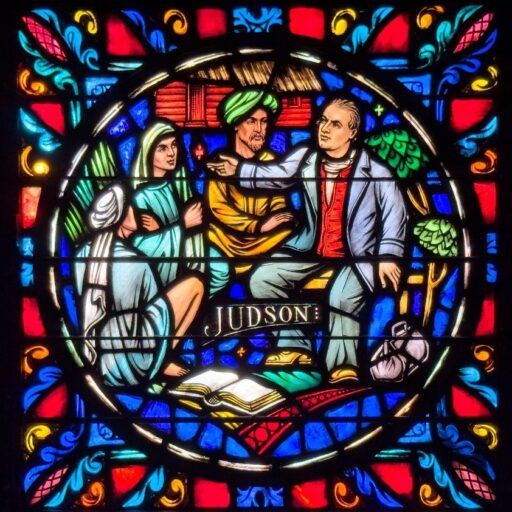1814-1855
Adoniram Judson Copeland
Congregational Minister ME/IL

Rev. Adoniram Judson Copeland is the first person discovered to date who was named for pioneer missionary Adoniram Judson, Jr. He represents the sixth generation of Copelands in America and the sixth of nine children born to William and Silence (Lane) Copeland. His birthday was March 10, 1814, but there is some discussion if he was born in Holden, ME, or Brewer, ME, hamlets just a few miles west of Bangor. Adoniram had a twin brother who was named Adonijah Judson Copeland but this twin lived only five months, passing away on August 3, 1814.[i]
Copeland’s alma mater, Bangor Theological Seminary, reports this paragraph:
Adoniram Judson Copeland was born at Brewer, ME, in March of 1814. He graduated from Bowdoin College in 1840, and from Bangor Theological Seminary in 1843. He was ordained as a Congregational minister and after preaching for a time in Maine, moved to Illinois and accepted a call as pastor of the Church at Como. Never formally incorporated, Como, was in northwestern Illinois, Whiteside County, near the town of Sterling on the Rock River. Copeland died in 1855.[ii]
In July, 1838, the village of Como, Illinois, was laid out on the banks of the Rock River with nine blocks making 142 lots for sale. Migrants were invited to “go west” and settle this new land and experience new opportunities.
The original proprietors of Como consisted of six civil engineers and surveyors, three ship captains, one clergyman [assumed to be Adoniram Judson Copeland], one editor, one printer and editor, one physician, one miller, one merchant, three shoe and leather dealers, and two farmers. The colonists were mostly natives of New Hampshire and Massachusetts, and were well educated, moral and hospitable people.[iii]
Before the Como church building was completed in 1850, Rev. Copeland moved to Geneseo, IL, and served as pastor of that Congregational Church from December, 1849, to February, 1852.[iv] He married Priscilla Smally on his birthday, March 10, in 1850. Adoniram and Priscilla had no children. Rev. Copeland died five years after his wedding date and was buried in Oakwood Cemetery in Geneseo, IL, “beloved by all who knew him.”[v] Adoniram Judson Copeland died on August 3, 1855, exactly 41 years after his twin brother Adonijah Judson Copeland died on August 3, 1814.
We do not know much about Rev. Copeland beyond the above summary but it is important to remember that before Adoniram Judson was a hero to the Baptists, he was a pioneering hero for the Congregationalists. Ann and Adoniram grew up in the Congregational Church and Adoniram was appointed as a missionary by the American Board of Commissioners for Foreign Missions founded in 1810 by the Congregationalists.
Thus in 1814, only two years after the Judsons had departed the US for missionary service, and nine months after the Judsons arrived in Burma, parents were naming their babies for these bold adventurers. William and Silence Copeland probably did not know that Ann had lost a stillborn son nor that the Judsons had been evicted twice from India before Adonijah and Adoniram Judson Copeland were born. These parents probably did not know the Judsons had resigned from the Congregational mission board and were unemployed in a foreign land when their sons were born in March of 1814.
We can only guess the motivations of the parents who named their child for this missionary they never met. We can assume they read The Panoplist and Missionary Magazine published for the Congregationalists by Samuel T. Armstrong in Boston with “All the Profits,.. devoted to the Support of Foreign Missions.”[vi] We can only imagine that A. J. Copeland felt the same call to go to the wilds of northwestern Illinois to establish Congregational churches to serve the spiritual needs of Natives and immigrants who were moving west as did Adoniram Judson, Jr. Adoniram Judson Copeland may have a story as captivating as that of his namesake.
[i] Warren Turner Copeland, Full Text of the Copeland Family: A Copeland Genealogy, (Rutland, Vermont: The Tuttle Publishing Company, Inc., 1937). Digitized by the Internet Archive in 2018, p. 113.
[ii] Adoniram Judson Copeland, https://www.biblicalcyclopedia.com/C/copeland-adoniram-judson.html
[iii] History of Hopkins Township, Whiteside County Illinois published by Genealogical Trails. Charles Bent, Whiteside County, Illinois, from its First Settlement to the Present Time, 1877, p. 6.
[iv] https://henry.illinoisgenweb.org/history-of-geneseo-churches.html
[v] Warren Turner Copeland, p. 113.
[vi] The Panoplist and Missionary Magazine (Boston: Samuel T. Armstrong), August (Part I), 1813, No 3, Vol IX, Front Cover.
